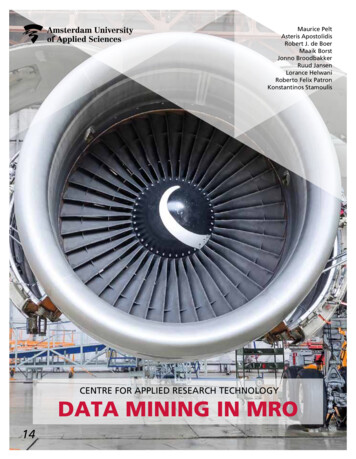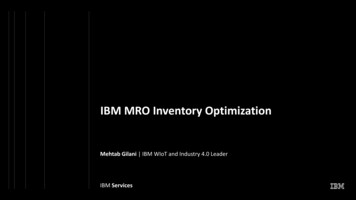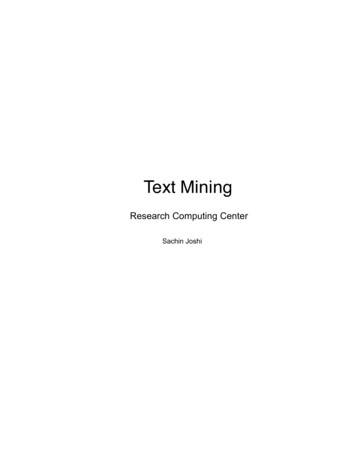
Transcription
Maurice PeltAsteris ApostolidisRobert J. de BoerMaaik BorstJonno BroodbakkerRuud JansenLorance HelwaniRoberto Felix PatronKonstantinos StamoulisCENTRE FOR APPLIED RESEARCH TECHNOLOGYDATA MINING IN MRO14
Earlier publications from this seriesKENNISCENTRUM TECHNIEKKENNISCENTRUM TECHNIEKKENNISCENTRUM TECHNIEKKENNISCENTRUM TECHNIEKVERTICAL FARMINGDUURZAAM BEWARENTECHNOLOGIE EN INNOVATIERICHTINGEN VOOR DE TOEKOMSTSIMULATIEMODEL EN TECHNOLOGIEËN VOOR ENERGIEBESPARINGInge OskamKasper LangePepijn ThissenInge OskamKasper LangeMarike KokEXTREME NEERSLAGBETER BEHEER MET BIMVAN INFORMATIEMODEL NAAR INFORMATIEMANAGEMENTANTICIPEREN OP EXTREME NEERSLAG IN DE STADPublications by Amsterdam University of Applied Sciences Faculty of TechnologyKENNISCENTRUM TECHNIEKHET STEDENBOUWKUNDIGBUREAU VAN DE TOEKOMSTSPIN IN HET WEBWillem VerbaanLéander van der VoetJelle de BoerErik VisserDiederik de KoeJeroen KluckRutger van HogezandEric van DijkJan van der MeulenAnnelies StraatmanPeter de BoisJoris DresenCamila PinzonElena SeleznevaCunera Smit0101 Vertical farming04030202 Duurzaam bewaren03 Extreme neerslag04 B eter beheer met BIMKENNISCENTRUM TECHNIEK(TERUG)SCHAKELENNAAR KETENDENKENCENTRE FOR APPLIED RESEARCH TECHNOLOGY05 StedenbouwkundigGREENING THE CLOUDResearch at the Faculty of TechnologyUNIEKE EIGENSCHAPPEN ENINSPIRERENDE TOEPASSINGSMOGELIJKHEDENPLANESENSE: PROCESS IMPROVEMENTIN AVIATION MAINTENANCEThe Faculty of Engineering of Amsterdam University of Applied Sciences is the largest technicalcollege in the Netherlands. The faculty consists of eight educational programmes with varied learning pathways and majors. A diverse range of educational programmes is offered, from Engineeringto Logistics; Civil Engineering to Forensic research; and Maritime Officer training to Aviation.Jeroen KluckLaura KleerekoperLisette KlokRonald LoeveWiebe BakkerFloris BoogaardCENTER FOR APPLIED RESEARCH TECHNOLOGYONTWERPEN METBIOBASED PLASTICSMAINTAINING YOURCOMPETITIVE EDGEINNOVATIES REALISEREN BIJ LOGISTIEK MKB IN MAINPORTSFaculty of Technology05bureau van de toekomstKENNISCENTRUM TECHNIEKIn this series of publications, Amsterdam University of Applied Sciences (AUAS) Faculty ofTechnology presents the results of applied research. The series is aimed at professionals and unlocksthe knowledge and expertise gained through practical research carried out by AUAS in theAmsterdam metropolitan area. This publication provides readers with the tools to achieveimprovement and innovation in the engineering sector.Research has a central place in the Faculty of Engineering. This research is rooted in innovation ofprofessional practice and contributes to the continuous improvement of the quality of education inthe Faculty as well as in practical innovations:Dick van DammeMelika LeveltSander OnsteinChristiaan de GoeijRover van Mierlo060706 (Terug)schakelenONDERZOEKSPROGRAMMA URBAN TECHNOLOGYRobert Jan de BoerMathijs MarttinEnos PostmaArjan StanderEric van de VenDamy Snel0807 Maintaining yournaar ketendenkenInge OskamMatthijs de JongMark LepelaarRogier ten Kate0908 Biobased plastics09 Greening the cloudcompetitive edgeONDERZOEKSPROGRAMMA URBAN TECHNOLOGYRECURFVan materiaal tot toepassingDE KLIMAATBESTENDIGE WIJKONDERZOEK VOOR DE PRAKTIJK10ONDERZOEKSPROGRAMMA URBAN TECHNOLOGYONDERZOEKSPROGRAMMA URBAN TECHNOLOGYRE-ORGANISESTADSLOGISTIEK:LICHT EN ELEKTRISCH Development of knowledge Innovation of professional practice Innovation of education10 D e klimaatbestendigewijkSLUITEN VAN STEDELIJKE KRINGLOPEN DOOR DECENTRALEVERWERKING VAN ORGANISCH BEDRIJFSAFVALOnderzoekscases stadslandbouwHERGEBRUIK VAN TEXTIEL IN BIOCOMPOSIETENRobert van den HoedEric HoekstraGiuseppe ProcacciantiPatricia LagoPaola GrossoArie TaalKay GrosskopEsther van BergenThe Faculty of Engineering has three research programmes, each of which is closely linked toan educational programme. These programmes are:LEVV-LOGIC:ONDERZOEK NAAR LICHTE ELEKTRISCHE VRACHTVOERTUIGEN1. Aviation2. Forensic Science3. Urban Technology1111 RecurfInge OskamMatthijs de JongMark LepelaarKim NackenhorstMartin BoeremaRogier ten KateDavine BlauwhoffPramod Agrawal1212 Re-OrganiseMaarten MulderJanne van den AkkerKasper LangeMarco van HeesJan Willem VerloopYannick SchrikInge OskamWalther Ploos van AmstelSusanne BalmJos WarmerdamMartin BoeremaMartijn AltenburgFrank RieckToin Peters1313 Stadslogistiek:Licht en elektrischThe AUAS Centre for Applied Research Technology is the place where the results of appliedresearch are bundled and exchanged.Text EditingThe series is published by the AUAS Faculty of Technology. The editorial board consists of professorsof the faculty. Each publication is compiled by a team of authors consisting of AUAS personnel, whoare sometimes supplemented by representatives of companies and/or other research institutions.0203
ColophonSummaryColophonAbstractPublisherData mining seems to be a promising way to tackle the problem of unpredictability in MROorganizations. The Amsterdam University of Applied Sciences therefore cooperated with theaviation industry for a two-year applied research project exploring the possibilities of data miningin this area. Researchers studied more than 25 cases at eight different MRO enterprises, applying aCRISP-DM methodology as a structural guideline throughout the project. They explored, preparedand combined MRO data, flight data and external data, and used statistical and machine learningmethods to visualize, analyse and predict maintenance. They also used the individual case studiesto make predictions about the duration and costs of planned maintenance tasks, turnaround timeand useful life of parts. Challenges presented by the case studies included time-consuming datapreparation, access restrictions to external data-sources and the still-limited data science skills incompanies. Recommendations were made in terms of ways to implement data mining – and waysto overcome the related challenges – in MRO. Overall, the research project has delivered promisingproofs of concept and pilot implementationsAviation Academy Research ProgrammeFaculty of Technology, Amsterdam University of Applied SciencesAuthorsMaurice Pelt, MSc.Asteris Apostolidis, PhDRobert J. de Boer, PhDMaaik Borst, MScJonno Broodbakker BSc.Roberto Felix Patron, PhDLorance Helwani, BSc.Ruud Jansen, BSc.Konstantinos Stamoulis, PhDText editorStephen Johnston, Scribe Solutions, www.scribesolutions.nlDesignNynke KuipersPrinted by:MullerVisual CommunicationFundingThis research was funded by Regieorgaan SIA, part of the Nederlandse Organisatie voor WetenschappelijkOnderzoek (NWO) (Dutch Organisation for Scientific Research).ContactMaurice Peltm.m.j.m.pelt@hva.nlHogeschool van Amsterdam, Faculteit TechniekPostbus 1025, 1000 BA AmsterdamMore informationISBN: 9789492644114This publication is also available tmlManagement SummaryThe aircraft maintenance process is often characterized by unpredictable process times andmaterial requirements. This problem is compensated for by large buffers in terms of time,personnel and parts. In order to stay competitive, Maintenance, Repair and Overhaul (MRO)companies are therefore looking for ways to organize their work as efficiently as possible.Data mining seems to be a promising way to tackle the problem of unpredictability in MRO.Based on these insights, several MRO SMEs turned to the Amsterdam University of AppliedSciences (AUAS) to explore the possibilities of using data mining for their businesses. Small andMedium Enterprises (SMEs) in MRO are important for the Dutch aviation industry, but they lackthe financial and data resources that larger companies have. We therefore initiated a jointresearch project with one main research question: How can SME MRO’s use fragmented historicalmaintenance (and other) data to decrease maintenance costs and increase aircraft uptime?The two-year ‘Data Mining in MRO’ applied research project was organized across 25 case studiesfor eight different MRO companies. CRISP-DM methodology was the preferred approach for thesestudies because it provides a structural guideline for organizing activities. CRISP-DM starts byidentifying factors in aircraft MRO that influence maintenance costs and uptime, and then definesdata mining goals. Relevant data sources from inside and outside the company are then exploredand evaluated. These data sets are subsequently cleaned and combined to be made ready forstatistical and machine learning methods that identify patterns and make predictions. Finally,the results are evaluated in terms of their practical value, and then deployed in the organization.Disclaimer: Centre for Applied Research Technology, Amsterdam University of Applied Sciences, February 20190405
SummaryThe case studies reflect a representative selection of the MRO companies and their typicalMRO challenges. Some examples include: The case studies can be divided into 3 groups of data mining approaches: The visualization of maintenance tasks that are executed long before they should be performedaccording to the maintenance instructions. This information was used to optimize maintenanceplanning in an airline MRO organization. Visualization: Descriptive analytics using established math and graphical methods, resulting inoutputs such as KPI control charts and management dashboards. Statistical Data Mining: Descriptive and predictive analytics using established statistical methods,such as probability calculation, correlation and time series forecasting. The prediction of the remaining useful tire lifetime based on six input parameters and usingregression algorithms. This led to better replacement planning in an airline MRO company. Machine Learning: Predictive analytics using machine learning methods such as regression,classification and clustering. The accurate prediction of required man hours for either planned or unplanned MRO tasks(findings) by automated selection of forecast algorithms and distribution functions. This wasimplemented in a maintenance tool for a SME MRO company. The identification of the main factors related to low lead-time accuracy of a componentmaintenance organization. Thirteen parameters and combinations were visualized and analyzedwith statistics and machine learning methods. The prediction of whether a certain component will need maintenance or not. The predictionaccuracy of seven machine learning methods using nine input parameters was evaluated, withthe resulting recommendation to add more external data. SummaryThe project led to the following findings and recommendations for implementing data mining in MRO: D ata mining is part of the strategy of the MRO company. Companies can offer a better proposition to their customers using data mining. They should assess their data mining maturity level, andthen start with descriptive analyses (visualization). This has proven to be very useful for MRO companies as they start data mining. Focused applications that target real problems obtain the bestresults. The human factor is very important in data mining in MROs. Companies should introduce datascientists into their organization who can select and implement the best data mining methods.It is equally important to train operational management and mechanics, because they generatethe data and use the new information sources to improve their work. Companies should alsoorganize close interaction between (academic) data scientists and shop floor mechanics. The introduction of data mining is associated with simultaneous changes in the processes of theMRO organization. Companies should adopt the CRISP-DM methodology to organize their datamining activities. Data visualization is a natural starting point in data analytics, and this methodology also allows companies to judge the quality of the data. Next is prediction and machinelearning. Companies should combine data- driven models with expert and failure models tocreate higher prediction accuracy. They should also negotiate with OEMs and asset ownersabout access to data. Knowledge is power and data is value. Data mining requires data sources and technology. Companies should increase data volume with(automated) maintenance reporting and sensors, along with business intelligence software suchas Tableau and Clikview or Avilytics. They should also let data scientists create models in opensource software such as R and Python. At the same time, they should modernize their ICT processes to support a data-driven approach. They can also investigate cloud computing, advancedactivity recording techniques and virtual reality solutions while determining the best methodsfor dealing with small data sets. The analysis of free text maintenance records using automated natural language processing(NLP). A dashboard was implemented for an airline MRO organization that automaticallytriggers alerts and extends the appropriate investigation.Turnaround time and MRO costs are systematically linked to data sources in aviation maintenance,so these case studies therefore delivered insightful results and conclusions. Of course, not allcompanies need the same level of data mining. This level depends on each company’s specificbusiness requirements and their maturity level in data science.The focus of almost all RAAK data mining research has traditionally been on the efficiency ofmaintenance operations (utilization). Fewer case studies have focused on TAT, and almost noneon extending the lifetime of a part. The CRISP-DM methodology therefore proved to be a goodframework for companies, and the sequence of phases and tasks as prescribed by this approach fitsvery well with the natural flow of project activities.Clearly, aviation maintenance companies are underutilizing the potential of data, due mainly todata protection and a focus on compliance rather than prediction. Although it would have beenbeneficial, the availability of external data from airline operators, suppliers and OEM’s washampered by confidentiality and ownership issues. Time-consuming data preparation work wasoften needed to make the data quality acceptable. In many case studies, sample sizes are thereforevery low for accurate diagnostics and prediction.Overall, the ‘Data Mining in MRO’ process optimization research project delivered promising proofs ofconcept and pilot implementations. It created valuable insights and recommendations about the feasibility and effectiveness of modern data science techniques at medium-sized maintenance companies.We would like to thank SIA for funding this research project.0607
Table of contentsTable of contentsTable of contentsAbstract .05Management Summary.051. Introduction.112. Understanding the maintenance business.132.1Maintenance, Repair and Overhaul.132.2The MRO Business.152.2.1 The Dutch MRO industry.152.2.2 Stakeholders in Aviation MRO.152.2.3 Business goals of Airlines and MROs.162.2.4 Competition in MRO.182.2.5 Smaller MROs under extra pressure.202.3The role of the Aviation Academy.202.4Innovations in aircraft maintenance.202.5Goals for MRO data mining.213. Data mining for SMEs.233.1Data mining in aviation MRO.233.2Barriers to data mining.233.3Problem statement and research questions.243.4Research methodology.243.5CRISP-DM.254. Understanding the data.274.1Common data sources in aviation.294.2Maintenance management systems in aviation MROs.314.3Access to data sources for MRO SMEs.314.4Data safety and human factors.324.5Checking data sets.365 Data preparation.395.1What are tidy data?.395.2Selecting data.405.3Cleaning data.405.4Constructing, integrating and formatting data.405.5Cleaning data sets.415.6Data preparation to improve MRO.435.7Data preparation concluding remarks.436. Analytics.456.1Introduction to analytics.456.2MRO analytics methods.486.3MRO prediction and the disadvantages of machine learning.526.4Classification of RAAK research.546.4.1 Group 1: Estimation with one parameter.566.4.2 Group 2: Time series.57086.4.36.4.46.4.56.4.66.4.7Group 3: Categorical distributions.57Group 4: Correlation / regression with statistics.58Group 5: Machine Learning.58Group 6: Other, mostly descriptive and optimization.59Group 7: Methods not tested in this project but that may be useful.617. Case studies evaluation and deployment.637.1Case study 1.647.2Case study 2.657.3Case study 3.687.4Case study 4.697.5Case study 5.707.6Case study 6.717.7Case study 7.727.8Case study 8.737.9Discussion of case study results.748. Concluding remarks.778.1Overall conclusion.778.2Conclusions about business understanding.788.3Conclusions about data understanding.788.4Conclusions about data preparation.798.5Conclusions about modelling.798.6Conclusions for evaluation and deployment.808.7Final remarks.818.7.1 CRISP-DM methodology.818.7.2 Uncertainty in MRO.818.7.3 Volume and quality of data.828.7.4 Physical models.838.7.5 Auto Machine Learning.839. Implementation s.879.4Information.8810. Appendix.9010.1Appendix: Case studies.9010.2Case Studies in cleaning data sets.9910.3Software: Comparison of R versus search Partners Data Mining in MRO.10409
1INTRODUCTIONMRO companies strive to stay competitiveMaintenance, Repair and Overhaul (MRO) companiesconstantly strive to stay competitive and respond tothe increasing demand for short and predictable aircraft turnaround times. As they work towards shorterand better controlled aircraft down times and lowermaintenance costs, they have identified process optimization as the key element for innovation in thisarea. MRO companies are therefore looking for options to organize their work as efficiently as possible.This study focuses on Small and Medium Enterprises(SMEs) in MRO. These companies are important forthe Dutch aviation industry, but they lack thefinancial and data resources of the larger companies.Lean processes are an essential part of increasing delivery reliability and shortening lead times. However, theaircraft maintenance process is always characterisedby unpredictable process times and material requirements. Lean business methodologies are unable tochange this fact. This problem is often compensatedfor by large buffers in terms of time, personnel andparts, leading to an expensive and inefficient process.Using data analytics to improve performanceIn order to tackle this problem of unpredictability,large aviation companies (as is the case in several othertypes of industries) have initiated projects to apply‘data analytics’ to improve their maintenance process.In theory, data analytics have a predictive value forthe maintenance process as a whole and the actualneed for the maintenance of separate components.However, MRO SMEs face certain challenges when itcomes to analytics. For instance, standardized dataavailability is a basic requirement for data analysis. ButMRO companies often rely on multiple IT systems fordata collection and storage, which results in fragmented data sets. In addition, MRO SMEs often have lessevolved IT systems compared to their larger counterparts. They rely on more rudimentary ways of collectingdata, which even further reduces data transparencyand blurs the potential that is hidden in the availabledata. MRO companies also exploit flight and externaldata (e.g., meteorological and airport data). Increasing-ly, these data are not accessible due to ownership orprivacy restrictions. Even if MRO SMEs are able to unlock the data, it is difficult to find meaningful patternswithin these data sets that have actual predictive value.CRISP-DM methodologyBased on these insights, several MRO SMEs turned tothe Amsterdam University of Applied Sciences (AUAS)to explore the possibilities of ‘data mining’ for theirbusinesses.Researchers at the Aviation Academy of the AmsterdamUniversity of Applied Sciences (AUAS) developed anapproach to implement data mining in MRO. It is basedon CRISP-DM methodology, which will be describedlater, as well as research from more than 25 cases atmany MRO companies. The results fulfill the specificneeds of these companies while also developing valuable insights into the maintenance industry as a whole.The research was funded by a grant from SIA.A step-by-step approachThis publication contains an approach – resultingfrom the project – aimed at introducing datamining methods to improve the competitiveposition of maintenance companies in aviation.Feedback is provided by participating companiesand research partners, which
The project led to the following findings and recommendations for implementing data mining in MRO: Data mining is part of the strategy of the MRO company. Companies can offer a better proposi-tion to their customers using data mining. They should assess their data mining maturity level, and then start with descriptive analyses (visualization).






![Welcome! [ nerc ]](/img/15/day-20two-20presentation.jpg)



